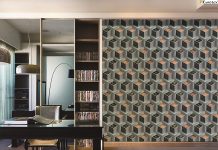Paint colors are often considered to be the simplest choice in decoration and interior design… while this decision is one of the most important steps in the development of one’s decor.
The color is a reflection of your personality. To achieve a color that sticks to your style, you need to know what you like, but more importantly, which palette best suits you. Then, you have to know how to integrate it into your decor according to the luminosity, architectural elements, coverings, etc.
To begin
Gather images of decors where the color of paint that you like. But don’t limit yourself to decoration! Choose images of all kinds (fashion, art, posters, etc.) that inspire you. Wallpaper and fabrics can also be a good starting point for a decorating primer!
If you call on a designer, this step will allow him to quickly understand your tastes and decorative aspirations.

Developing a palette
It is from these inspirations that one can begin to develop a palette of paint colors for one’s home. If you are starting from scratch, you can go in any direction, but if you are like most of my clients, and already have colorful furniture and upholstery, you will have to take this into account.

The coloring of this dining room was done from the fabrics on the chairs and the eggplant counters in the kitchen. On an immaculate white background, we added an apple green on a small area, which we arranged with sections of colored curtains. In the living room, which is right next door, we used touches of eggplant on the walls to make a link with the fabric of the chairs and the colors found in the kitchen. Note: a very dark paint color cohabits marvelously with very light shades.

Since the elements in place (fixtures and coverings) in this basement bathroom were very neutral, we could go just about anywhere for the colors. This fashion photo inspired us for the coloring. We wanted to bring optimism to this bathroom that initially seemed quite ordinary. The shades were toned down to avoid the overly striking effect of the paint color. In decoration, if you use saturated (vibrant) or dark colors, you must do so with restraint. We have chosen the darker blue, and we have washed out the green to avoid the two colors fighting against each other.

Also read: Decorative Painting – 50+ Amazing Tips
A work of art can very well be the basis of a paint color palette for your home. The coloring of this dining room is perfectly homogeneous. Different declinations of blues and turquoises have been carefully chosen in the fabrics, objects, and the color on the walls.

The coloring of these open space rooms was made according to the indigo blue sofa that we had to keep. We opted for a very warm grey as a backdrop, and we pushed the note with a mauve blue. Notice how the well-zoned touches of color give a lift to this space.

The paint color of the walls is very often the last thing to choose from. Here, we had a crush on this beautiful wallpaper. It is from it that we chose the ceramic in which we found the golden shine found in the wallpaper. To support these choices, we opted for a white/cream that marvelously gathers the elements found in this room.
In any coloring project, the important thing is to find inspiration and a starting point. Gather as many elements as possible that need to be taken into account (coverings, fabrics, objects, artwork, decorative elements, etc.), and search for images that inspire you. This step should not be done in a hurry, especially if you really want to put your mark on your decoration and your choice of paint color!
Translated and adapted by Noobuzz staff.
Sources: Canalvie







